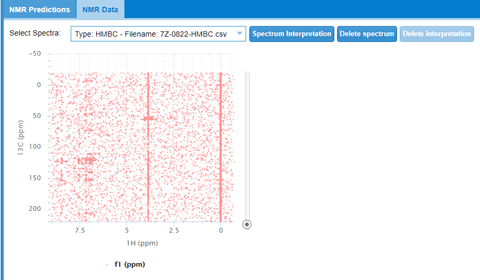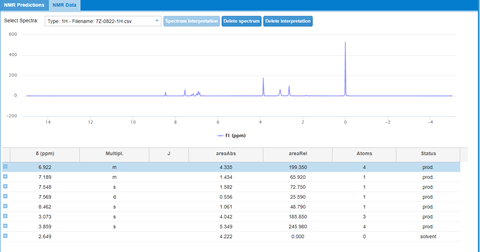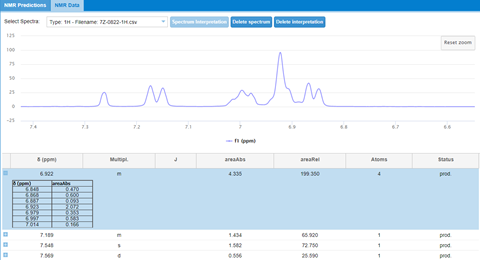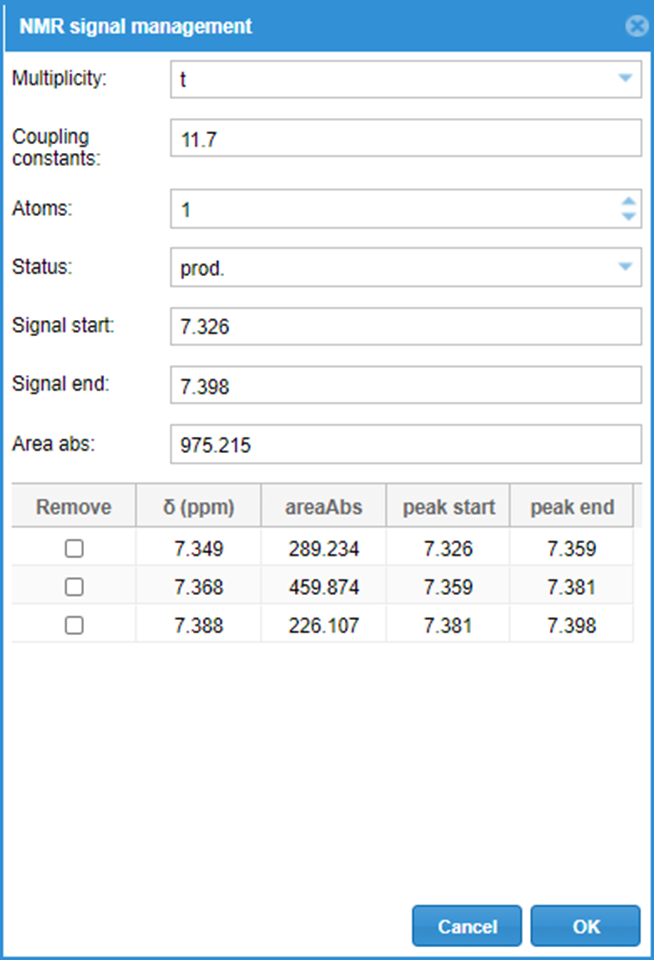Prediction of NMR chemical shift and multiplicity
The WebChembase system provides a button to get the 1H and 13C prediction for the compound of interest. IN order to do so, the user must configure the NMR prediction tool that can be used, Charming. This program is distributed by Lead Molecular Design (https://www.leadmolecular.com/charming-nmr-prediction/ ), follow the settings in Oniro to configure the application. After the computation is done the results are shown below.

Compound Library – Small Molecules- Compound edition – NMR prediction panels
The results are shown in 3 panels that are connected.
- 1H panel: This panel contains the table for the NMR prediction:
- Columns:
- Atom ID: This column shows the identification number for the atoms.
- (ppm): This column has the predicted chemical shift.
- Multiplicity: This column contains the multiplicity consider distance of 3 bonds (3J) or distance 4 bonds (4J) separated by the “/” separator. Also, it provides the prediction of the coupling constants.
- Integral: This column has the suspected number of atoms with the same chemical shift, in this case it should correspond to the relative integral that might be found in a spectrum.
- Rows: Every row in this table correspond to a predicted signal in the NMR spectra. by clicking one row, the system shows the corresponding atom in the middle panel.
- Columns:
- Structure panel: This panel shows the structure of the compound under analysis. By clicking the atoms, the rows in the 1H and 13C panels are highlighted and if a row is selected in any of 1H and 13C panels the corresponding atom will be marked in this middle panel.
- 13C panel: This panel contains the table for the NMR prediction:
- Columns:
- Atom ID: This column shows the identification number for the atoms.
- (ppm): This column has the predicted chemical shift.
- Multiplicity: This column contains the multiplicity consider distance of 3 bonds (3J) or distance 4 bonds (4J) separated by the “/” separator. Also, it provides the prediction of the coupling constants.
- Integral: This column has the suspected number of atoms with the same chemical shift, in this case it should correspond to the relative integral that might be found in a spectrum.
- Rows: Every row in this table correspond to a predicted signal in the NMR spectra. by clicking one row, the system shows the corresponding atom in the middle panel.
- Columns:
Reading and interpretation of NMR data
The WebChembase system provides a button to introduce the NMR experimental data into the Compound Library. A new window will pop-up to upload the NMR files. The user can select the type of spectra that can be used for the interpretation.: 1H, 13C, COSY, HSQC and HMBC are available. After the file has been uploaded the user can select it from Select spectra are in the NMR Data tab.




Compound Library – Small Molecules- Compound edition – NMR spectra – 1H – 13C – COSY – HMBC
There are 3 functionalities accessible:
- Spectrum Interpretation: This option is used to interpret the spectra under consideration. In case of the 2D spectra, fist the 1D has to be spectra.

Compound Library – Small Molecules- Compound edition – NMR interpretation
The information from the interpretation is divided in 2 parts:
- Spectra:
- Table:
- Columns:
- (ppm): This column has the measured chemical shift.
- Multiplicity: This column contains the multiplicity.
- J: This column represents the coupling constant.
- AreaAbs: This is the absolute area measured for every peak.
- AreaRel.: This is the relative area to the smallest peak.
- Atoms: This column represent the number of atoms assigned to every signal.
- Status: This column indicates the Status of the signal. It values can be:
- prod: to be assigned to the product under analysis,
- imp: impurity, which is assigned to the small signal not bellowing to the product and
- solvent: this is the signal assigned to the solvent.
- Rows: Clicking on the left upper icon in each row the user can expand and look the peaks that are associated with the signal under consideration.
- Columns:
- Table:

Compound Library – Small Molecules- Compound edition – NMR interpretation – view peaks
- Double Click: By double clicking on a signal the user can edit the multiplicity the number of atoms assigned to the signal and the Status. The system detects the number of peaks and compute the multiplicity and the coupling constants

Compound Library – Small Molecules- Compound edition – NMR interpretation – Edit signals
- Multiplicity: This is the multiplicity for the signal selected. the multiplicity could be automatically computed depending on the peaks active in the signal or the user can edit this field and add the value.
- Coupling constants: This field contains the coupling constant of the signal. It can be automatically computed by the system of it can added by the user.
- Atoms: Number of atoms assign to this signal.
- Status: This is the assigned status to the signal. It can be prod, if it is a signal that belongs to the product, imp: if the signal is associated to an impurity and solv: if the signal corresponds to a solvent.
- Signal start: This value indicates the start of the signal in the chemical shift scale.
- Signal end: This value indicates the start of the signal in the chemical shift scale.
- Area Abs: This is the Absolute computed area for the signal range selected.
- Peak table:
- Columns:
- Remove: Click this box to remove the peak from the computation. It will automatically recompute the multiplicity and the coupling constants
- Chemical shift (ppm): This is the chemical shift associated with the peak that will be used to compute the coupling constant if necessary.
- Area ABs: This is the absolute area of the peak.
- Peak start: This is the start of the peak.
- Peak end: This is the end of the peak
- Rows: Each peak found between the starts and the end of the signal
- Columns:
